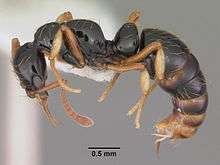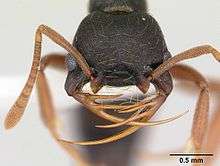Thaumatomyrmex
Thaumatomyrmex is a Neotropical genus of ants in the subfamily Ponerinae, found from Mexico to Brazil. They are notable for their pitchfork-shaped mandibles, which they use to capture millipedes of the order Polyxenida. The genus is a specialist predator of polyxenids, and one of only two ant genera known to prey upon polyxenids.
| Thaumatomyrmex | |
|---|---|
 | |
| T. atrox worker from Peru | |
| Scientific classification | |
| Kingdom: | |
| Phylum: | |
| Class: | |
| Order: | |
| Family: | |
| Subfamily: | |
| Tribe: | |
| Genus: | Thaumatomyrmex Mayr, 1887 |
| Type species | |
| Thaumatomyrmex mutilatus[1] Mayr, 1887 | |
| Diversity[2] | |
| 12 species | |
Taxonomy and phylogenetics

The genus was established by Mayr in 1877 to house the single species Thaumatomyrmex mutilatus, discovered in Brazil.[3] Since its inception, the genus has been placed in various tribes: Ectatommini, Ponerini, Cylindromyrmicini, and its own tribe, Thaumatomyrmecini. Molecular phylogeny by Schmidt & Shattuck (2014) confirmed that the genus is nested within Ponerini.[4] Twelve species has been described, and a few undescribed taxa are known.[5]
Distribution
Thaumatomyrmex is found only in the Neotropics, from Mexico to Brazil (including Cuba and other Caribbean islands). The genus was once thought to be rare, but with better sampling techniques, the ants are now found more frequently.[5]
Description
Workers are small in size (3.3–5.0 mm) and have pitchfork-shaped mandibles with three long teeth. They are specialist predators of millipedes of the order Polyxenida.[4] Polyxenids are an unusual type of prey, only known to be preyed upon by Thaumatomyrmex and Probolomyrmex ants. The millipedes are covered with hooked bristle setae, which entangles potential predators. Thaumatomyrmex use their long mandibles to hold the polyxenids before immobilizing them by stinging, and then stripping the prey from their protective setae.[5] The brush-like hairs on the workers' legs are used to scrape the setae off "like cleaning a chicken".[6] Workers forage individually in the leaf litter.[4]
Alate queens remain undescribed, although Kempf (1975)[7] mentioned an alate T. zeteki queen in the collections of the U.S. National Museum, this has however never been confirmed. Gamergates (reproductive female workers) are known from at least two species (T. atrox and T. contumax).[4]
Species
- Thaumatomyrmex atrox Weber, 1939
- Thaumatomyrmex bariay Fontenla Rizo, 1995
- Thaumatomyrmex cochlearis Creighton, 1928
- Thaumatomyrmex contumax Kempf, 1975
- Thaumatomyrmex ferox Mann, 1922
- Thaumatomyrmex mandibularis Baroni Urbani & De Andrade, 2003
- Thaumatomyrmex manni Weber, 1939
- Thaumatomyrmex mutilatus Mayr, 1887
- Thaumatomyrmex nageli Baroni Urbani & De Andrade, 2003
- Thaumatomyrmex paludis Weber, 1942
- Thaumatomyrmex soesilae Makhan, 2007
- Thaumatomyrmex zeteki Smith, 1944
References
- "Genus: Thaumatomyrmex". antweb.org. AntWeb. Retrieved 13 October 2013.
- Bolton, B. (2015). "Thaumatomyrmex". AntCat. Retrieved 5 January 2015.
- Mayr, G. (1887). "Südamerikanische Formiciden". Verhandlungen der Kaiserlich-Königlichen Zoologisch-Botanischen Gesellschaft in Wien. 37: 511–632.
- Schmidt, C. A.; Shattuck, S. O. (2014). "The Higher Classification of the Ant Subfamily Ponerinae (Hymenoptera: Formicidae), with a Review of Ponerine Ecology and Behavior". Zootaxa. 3817 (1): 1–242. doi:10.11646/zootaxa.3817.1.1. PMID 24943802.
- Rabeling, C; Verhaagh, M.; Garcia, MVB. (2012). "Observations on the specialized predatory behavior of the pitchfork-mandibled ponerine ant Thaumatomyrmex paludis (Hymenoptera: Formicidae)". Breviora (533): 1–8.
- E. O. Wilson (professor emeritus, Harvard) in an interview in New Scientist issue No3005 page 29
- Kempf, W. W. (1975). "A revision of the Neotropical ponerine ant genus Thaumatomyrmex Mayr (Hymenoptera: Formicidae)". Studia Entomologica. 18: 95–126.
External links
